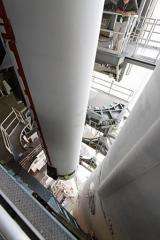This NASA handout photo shows the mobile service tower at Launch Complex 37 on Cape Canaveral Air Force Station in Florida, a solid rocket booster for the Delta IV rocket, slated to launch NASA's GOES-P satellite as it is lowered toward the base of the rocket. NASA on Thursday launched the latest in its family of high-tech meteorological satellites.
NASA on Thursday launched the latest in its family of high-tech meteorological satellites, adding to a constellation of spacecraft that watch storm development and weather conditions on Earth.
The Geostationary Operational Environmental Satellite-P (GOES-P) lifted off from Cape Canaveral in Florida at 6:57 pm (2357 GMT) on a Delta IV rocket which will carry the weather-watching satellite to its orbit around 22,000 miles (35,406 kilometers) above the Earth's surface.
"GOES-P is on its way into orbit to begin a 10-year mission to keep a watchful eye on our world," NASA said on the satellite's launch blog, noting that all systems were performing "exactly as expected."
Once it reaches its orbit, GOES-P will collect and send back to Earth data that will be used by scientists to monitor weather, make forecasts and issue warnings about meteorological incidents.
The satellite will also detect ocean and land temperatures, monitor space weather, relay communications and provide search-and-rescue support.
GOES-P is the latest in a long line of GOES satellites, the first of which was launched in 1975.
The satellite will drop its letter suffix for a number, becoming GOES-15 once it is in space.
The satellite is a joint project of the US space agency, NASA, and the National Oceanic and Atmospheric Administration (NOAA), which oversees the US National Weather Service.
The launch was carried out by United Launch Alliance, a joint venture of Boeing and Lockheed Martin.
GOES satellites are "the backbone of NOAA's severe weather forecasts, monitoring fast-changing conditions in the atmosphere that spawn hurricanes, tornadoes, floods and other hazards," said Steve Kirkner, GOES program manager at NASA's Goddard Space Flight Center in Maryland.
Instruments on board the latest in the GOES family include an imager that senses energy from areas of Earth, and a "sounder" that uses a scan system to gather data from which scientists can calculate temperatures, moisture profiles and ozone distribution.
The satellite also has a space environment monitor, which will beam real-time data to Earth about energetic particles in space that pose a risk to satellites and astronauts and can disrupt navigation and communications systems.
The space environment monitor includes an X-ray telescope that will measure solar X-ray emissions and the intensity and duration of solar flares, which can lead to changes in ionospheric conditions that disrupt radio communications and Global Positioning System (GPS) signals.
A key piece of equipment on GOES-15 is the Solar X-Ray Imager, which will capture an image of the sun's atmosphere every minute, providing space weather forecasters with information they need to determine when to issue alerts of conditions that may harm space and ground systems.
(c) 2010 AFP





















